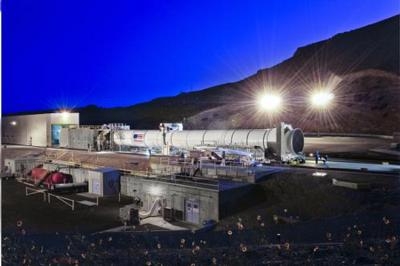Fri, Aug 08, 2014
NASA And ATK Say They Are On Schedule For 2017 Launch
ATK has successfully completed its Critical Design Review (CDR) with NASA to verify that the five-segment solid rocket booster is on track for an unmanned, first flight of NASA's Space Launch System (SLS) in 2017. The SLS vehicle is planned to launch humans deeper into space than ever before.

"Achieving this milestone is a tremendous accomplishment for ATK and NASA as we continue building the boosters for America's Space Launch System," said Charlie Precourt, vice president and general manager of ATK's Space Launch division. "Deep space exploration requires a heavy lift vehicle, and SLS is the only vehicle with the mass, volume and speed required for human missions to destinations such as the moon, an asteroid or Mars."
With the successful completion of CDR, the SLS booster design can now proceed toward qualification testing. Booster avionics qualification efforts are also in work and will be incorporated into the vehicle qualification effort that is scheduled for completion in 2016.
"ATK's technology innovation, process improvements and lean manufacturing will enable SLS to deliver humans and cargo to deep space faster, safer and more affordably than any other existing or planned vehicle," said Precourt, who is also a four-time space shuttle astronaut. "It is exciting to see that the teams working on SLS and the Orion crew capsule are all making steady progress toward NASA achieving a human mission to Mars by the 2030s."
A ground static firing of the full-scale booster, Qualification Motor-1 (QM-1), is planned for late this year/early next year at ATK's facility in Promontory, Utah. The next major booster milestone will be the Design Certification Review scheduled for fall of 2016.
Other upcoming SLS and Orion program milestones include a firing of the modified RS-25 engine this fall and the opening of the SLS Vertical Assembly Center, which is where the rocket's core stage fuel tanks will be welded. Orion's first flight, scheduled for December 2014, will be the farthest a human-rated spacecraft has traveled into space in more than 40 years.
(Image provided by ATK)
More News
Aero Linx: Model Aeronautical Association of Australia MAAA clubs are about fun flying, camaraderie and community. For over 75 years, the MAAA has been Australia’s largest fl>[...]
Touchdown Zone Lighting Two rows of transverse light bars located symmetrically about the runway centerline normally at 100 foot intervals. The basic system extends 3,000 feet alon>[...]
“Discovery and innovation are central to our mission at Virgin Galactic. We’re excited to build on our successful record of facilitating scientific experiments in subor>[...]
How To Get A Story On Aero-TV News/Feature Programming How do I submit a story idea or lead to Aero-TV? If you would like to submit a story idea or lead, please contact Jim Campbel>[...]
Student Pilot Reported That During Rotation, “All Of A Sudden The Back Of The Plane Kicked To The Right..." Analysis: The student pilot reported that during rotation, “>[...]
 ANN's Daily Aero-Linx (05.02.24)
ANN's Daily Aero-Linx (05.02.24) ANN's Daily Aero-Term (05.02.24): Touchdown Zone Lighting
ANN's Daily Aero-Term (05.02.24): Touchdown Zone Lighting Aero-News: Quote of the Day (05.02.24)
Aero-News: Quote of the Day (05.02.24) ANN FAQ: Contributing To Aero-TV
ANN FAQ: Contributing To Aero-TV NTSB Final Report: Cirrus Design Corp SR20
NTSB Final Report: Cirrus Design Corp SR20



